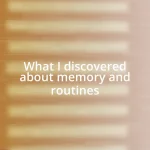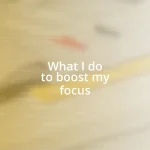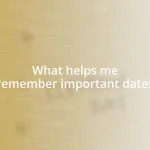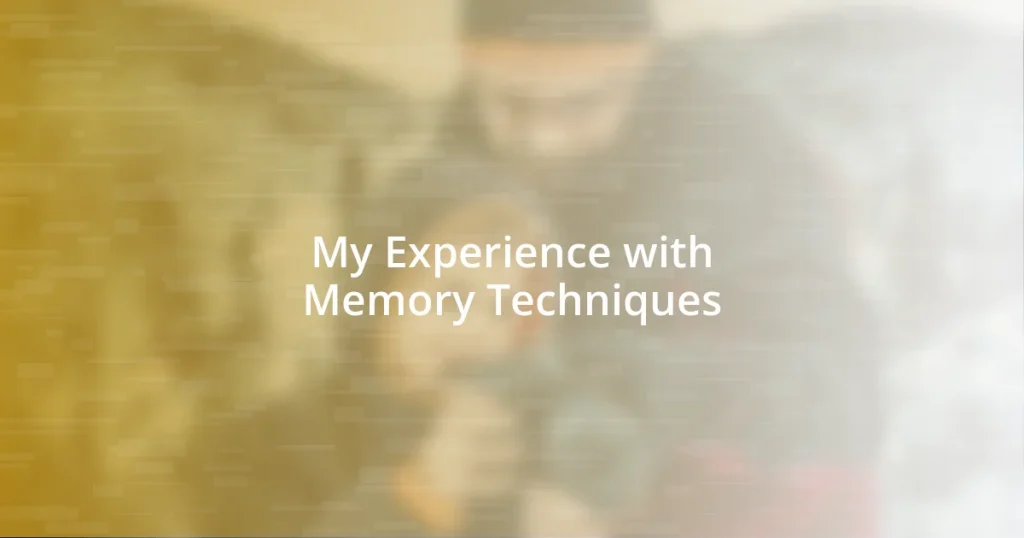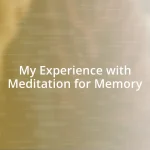Key takeaways:
- Memory techniques like mnemonics, visualization, and chunking greatly enhance retention and recall of information.
- Combining different techniques and understanding personal learning styles lead to more effective memory practices.
- Applying memory techniques in real life, such as using memory palaces and storytelling, enriches learning and fosters stronger connections with others.

Understanding Memory Techniques
Memory techniques are fascinating tools that transform the way we retain and recall information. I remember the first time I used a mnemonic device to memorize a list of items. It was a game-changer; suddenly, those random words became a vivid story, and I could recite them effortlessly. How many times have you wished you could recall someone’s name or a vital piece of information with ease?
Diving deeper into these techniques, I’ve found that visualization plays a significant role. Picture this: when I needed to remember a complex concept for a presentation, I imagined it as a bright, colorful image in my mind. I could almost see it in detail, which made the information stick. Isn’t it remarkable how our brains respond so well to imagery?
Additionally, chunking is another effective method I’ve experienced firsthand. When trying to memorize long strings of numbers, I broke them down into smaller groups, just like we do with phone numbers. This simple strategy turned what seemed like a daunting task into a manageable one. Have you ever tried breaking down complex information? It can make all the difference in how we engage with and understand the material.
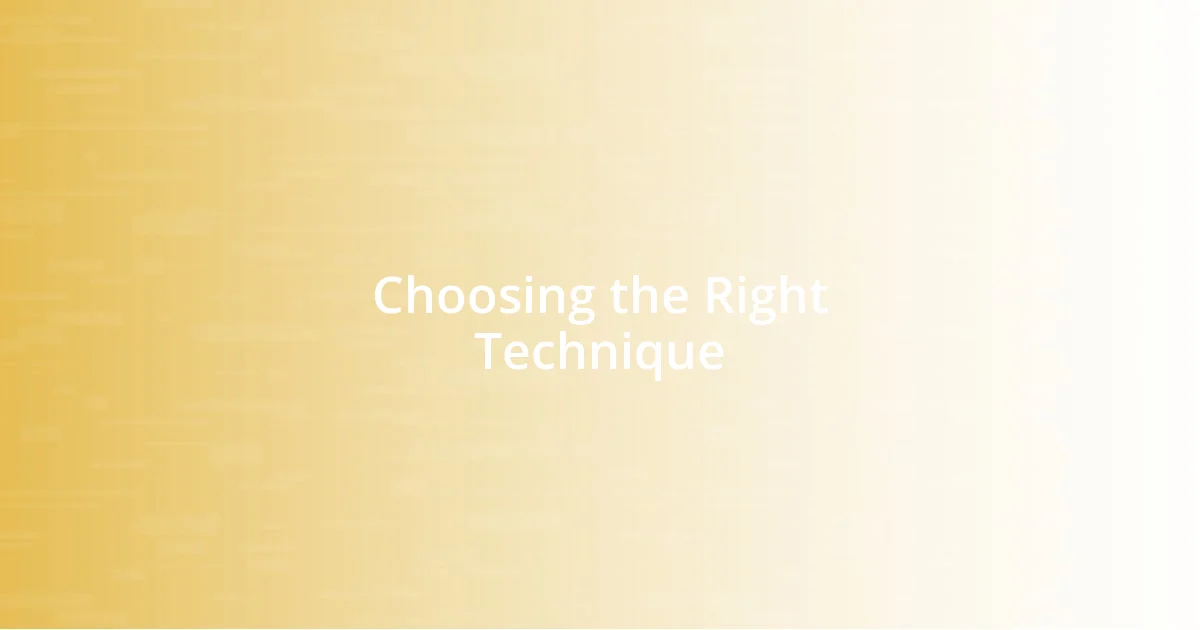
Choosing the Right Technique
Choosing the right memory technique can feel overwhelming, given the variety available. I vividly recall feeling lost while deciding between mnemonic devices or visualization. Ultimately, it took some experimentation to realize that combining techniques often yielded better results. Have you ever found that blending methods works for you too?
On another occasion, I tried chunking when learning a new language. Instead of memorizing individual words, I grouped them into phrases that fit within everyday conversations. It felt like unlocking a door to new comprehension. This approach not only made learning efficient but also added joy to the experience, as I could see my progress with each grouped phrase.
When I finally understood my learning style preferences, everything changed. For instance, I learned I thrive on visual aids, which is why I always surround myself with colorful charts and diagrams. Recognizing what resonates with me has helped me refine my memory techniques. It’s essential to pay attention to how you feel when using these techniques; our emotions can guide us towards the methods that work best.
| Technique | Best For |
|---|---|
| Mnemonic Devices | Lists and sequences |
| Visualization | Complex concepts |
| Chunking | Long strings of data |
| Association | Connecting new info with existing knowledge |
| Spaced Repetition | For long-term retention |

Creating a Memory Palace
Creating a memory palace is one of my favorite techniques to enhance recall. The concept involves visualizing a familiar place and associating specific pieces of information with various locations within it. Once, while preparing for a big exam, I imagined my childhood home and placed different topics in each room. It felt like walking through my past while revisiting those crucial concepts, making it both nostalgic and effective. This method not only made studying enjoyable but also deeply connected the material to the places I love.
To build your own memory palace, consider these steps:
- Choose a familiar location: It could be your home, school, or even a route you frequently take.
- Identify distinct rooms or landmarks: Think about how to divide the information logically.
- Visualize and place information: Imagine each piece of data vividly in specific spots. The more unusual or funny the image, the better it sticks!
- Walk through your palace: Mentally revisit the location, recalling details as you move through it.
This process truly transforms information into memorable experiences; I still smile thinking of the wild images I used to represent my study materials!
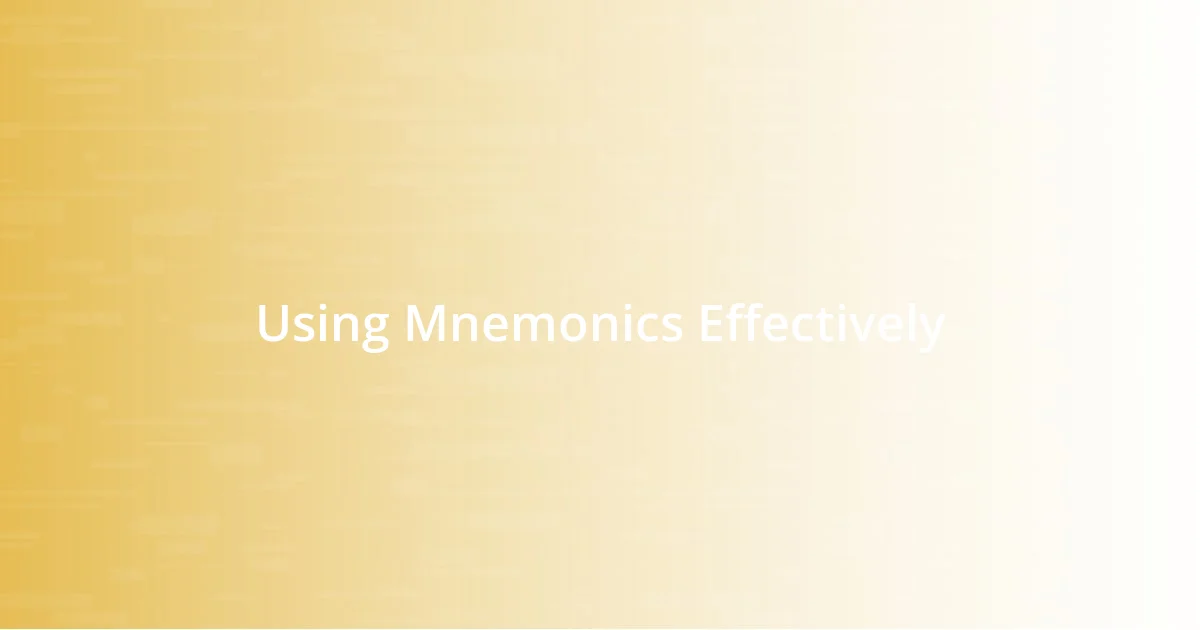
Using Mnemonics Effectively
Utilizing mnemonics effectively requires a bit of personalization. For me, creating vivid imagery has been a game-changer. I remember when I tried to memorize a long list of grocery items; instead of rote memorization, I envisioned a wild scene in my kitchen where my bread was performing ballet with the eggs. It was absurd, but that quirky image helped me recall each item without much effort later on. Have you ever found humor in your mnemonic images? It really makes the learning process more enjoyable.
Another technique that influenced my memory retention was association. When I wanted to remember the names of my new colleagues, I linked their names to familiar personalities or characters from my favorite shows. That way, Hilda became my go-to reference for a bold cartoon character, and her name stuck effortlessly. It’s fascinating how our brains connect new information to existing knowledge. I wonder if you’ve ever tried connecting new concepts to something within your own life—how did that work for you?
Combining different mnemonic techniques has also been quite valuable for me. I often use a mix of chunking and spaced repetition, especially when revisiting material. I recall studying for a history exam where I first broke the timeline into chunks—decades, events, and influential figures. Then, I revisited those chunks at intervals over several days. It felt like planting the seeds of knowledge and watching them grow stronger with each review. Isn’t it amazing how our memory works when we give it a little more structure?

Practicing Recall with Spaced Repetition
Practicing recall through spaced repetition has genuinely transformed my learning journey. I remember when I first tried this method while studying for a language quiz. Instead of cramming everything in one go, I spaced out my reviews over a week. Every time I came back to the vocabulary, I felt a thrill as the words started to stick, like old friends reintroducing themselves. Have you ever experienced that delightful moment when something finally clicks after repeated exposure?
The beauty of spaced repetition lies in its timing. I found that waiting just the right amount of time before revisiting a topic made a huge difference in how well I retained the information. If I came back too soon, I felt like I was merely skimming the surface; if I waited too long, the knowledge would fade away. I often reflected on this balance, much like tending to a garden—too much water, and you drown the plants; too little, and they wither. Do you have a rhythm that works for you in reviewing material?
Using apps designed for spaced repetition has been a game-changer for me. I vividly recall using one while prepping for a certification exam. The notifications would pop up like delightful reminders, prompting me to revisit topics just at the right moment. It was empowering to see my progress displayed visually, knowing that each review solidified my understanding. Haven’t you ever felt a rush looking at your improvements? It turned study sessions into a rewarding experience, fueling my motivation for deeper learning.

Tracking Progress and Results
Tracking my progress with memory techniques has been an enlightening journey. I often keep a journal where I log my experiences, noting what techniques worked best for specific topics. For instance, when I began using visual associations for complex subjects like biology, I could directly see a marked improvement in my retention rates. Have you ever thought about how documenting your learning experiences might lead to valuable insights?
I also use self-testing as a reliable method for gauging my improvement. I remember one occasion when I took an online quiz after revising a chapter using mnemonic devices. The moment I scored higher than my previous attempts, it felt like a mini-celebration. Isn’t it gratifying to see tangible results from your efforts? That burst of confidence often motivates me to dive deeper into the subject matter.
Reflecting on my results has allowed me to tweak my techniques effectively. When I noticed that particular images weren’t sticking, I experimented with different mental visuals, shifting the focus from clarity to emotional resonance. I realized that memories connected with emotions tend to stay longer. Have you ever found that a certain emotional experience can enhance your learning? Overall, tracking progress transforms memory work into a more personalized and dynamic activity.

Applying Techniques in Daily Life
Applying memory techniques in daily life has provided me with immense benefits, enhancing both my personal and professional experiences. One strategy I’ve embraced is the use of memory palaces. I remember walking through my favorite park, visualizing each bench as a different piece of information I needed to remember for an upcoming presentation. Could you imagine turning your surroundings into a vibrant repository of knowledge? That shift in perspective made learning feel less like a chore and more like an exploration of familiar spaces.
Another technique I found effective is storytelling. By crafting narratives around key concepts, I’ve discovered that I can link ideas in a way that feels natural. For instance, while studying financial concepts, I created a story surrounding a character trying to navigate their way through a bustling market. Have you ever noticed how stories can evoke strong emotions and make information more relatable? This approach not only enhances retention but also makes the learning process enjoyable.
Finally, incorporating memory techniques into everyday conversations has proven invaluable. I started testing myself by recalling names and details about the people I meet, like connecting their interests to my own experiences. There’s an undeniable satisfaction in recalling someone’s favorite book or hobby without stumbling. Have you ever felt that warm sense of connection when you remember someone’s details? It enriches my interactions and helps build deeper relationships, making each encounter memorable in its own unique way.



